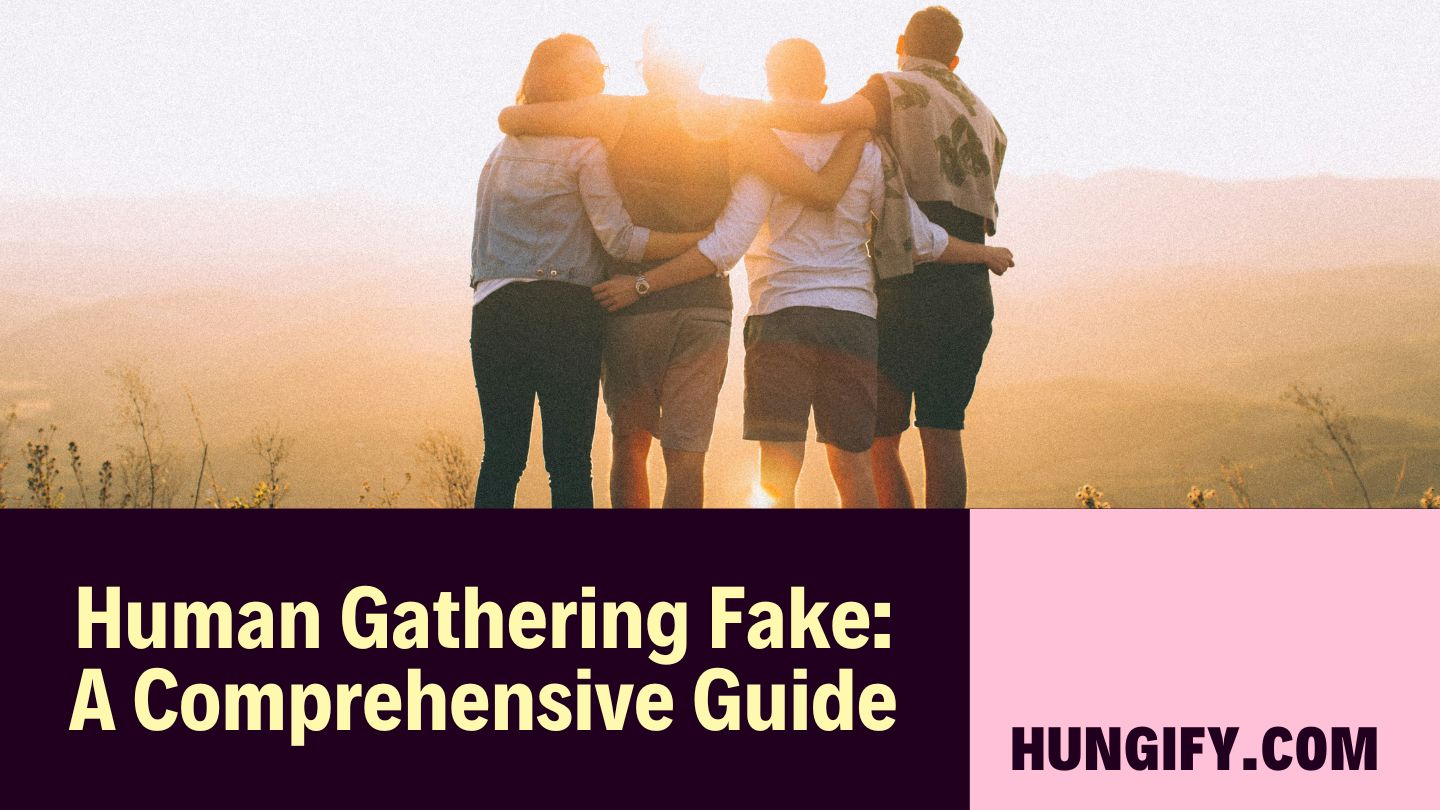Introduction
Human gathering fake refers to events or gatherings that are artificially created or manipulated to deceive people. Understanding the concept of fake gatherings is crucial in today’s digital age where misinformation spreads rapidly. This article will explore the psychological manipulation involved, its impact on society, and ways to identify and combat fake gatherings.
Psychological Manipulation in Human Gathering Fake
Techniques Used to Influence Behavior
Human gathering fake relies heavily on psychological tactics to influence people’s behavior. Techniques such as social proof, authority bias, and scarcity are commonly used to create a sense of urgency or trustworthiness. These methods manipulate individuals into believing and participating in fake events.
Exploiting Trust and Credibility
Perpetrators of human gathering fake often exploit the inherent trust people place in reputable sources. By impersonating trusted entities, they disseminate false information, gaining unauthorized access to sensitive data or influencing public opinion.
You May Also Read: How Netwyman Blogs Can Help in SEO Rankings?
The Impact on Individuals and Society
Social Implications of Fake Gatherings
Fake gatherings can erode trust within communities, leading to a breakdown in social cohesion. People become wary of attending events, fearing they might be deceived again. This mistrust can have long-lasting effects on community engagement and participation.
Psychological Effects on Participants
Individuals who fall victim to fake gatherings may experience feelings of betrayal, embarrassment, and disappointment. These negative experiences can affect their willingness to engage in future social activities, leading to increased social isolation.
Economic Consequences
Businesses and sponsors that invest in fake gatherings face significant financial losses and reputational damage. The broader economy may also suffer as consumers become hesitant to spend on event-related products and services.
Identifying Human Gathering Fake
Red Flags and Warning Signs
Recognizing the signs of a fake gathering is crucial. Red flags include a lack of credible sources, grammatical errors in promotional materials, and inconsistencies in event details. Attendees should always verify the authenticity of an event before participating.
Verifying Event Authenticity
To verify the authenticity of an event, check the credibility of the organizers, cross-reference information from multiple reliable sources, and look for official endorsements or partnerships. Utilizing fact-checking tools and websites can also help in identifying fake events.
Tools and Techniques for Detection
Advanced detection tools, such as AI and machine learning algorithms, can analyze patterns and verify information to identify fake gatherings. These technologies help prevent the spread of misinformation by flagging potentially false events.
The Role of Social Media in Human Gathering Fake
How Fake Gatherings Spread Online
Social media platforms play a significant role in the proliferation of fake gatherings. Viral content, driven by algorithms that prioritize engagement, can quickly spread misinformation. Fake events often gain traction through likes, shares, and comments, creating an illusion of legitimacy.
Impact of Algorithms and Viral Content
Algorithms on social media platforms often favor sensational or emotionally charged content, leading to the rapid dissemination of fake gatherings. This bias towards engagement over accuracy can amplify the reach of deceptive events.
Case Studies and Examples
Numerous examples of fake gatherings spreading through social media highlight the need for vigilance. From false protests to sham conferences, these cases demonstrate the widespread impact and potential harm of misinformation.
Combating Human Gathering Fake

Strategies for Individuals and Communities
Individuals can combat fake gatherings by developing critical thinking skills and media literacy. Communities can organize workshops and educational programs to raise awareness about the dangers of misinformation and how to identify it.
The Role of Technology in Detection
Technological solutions, such as blockchain for transparency and AI for content verification, can play a crucial role in detecting and preventing fake gatherings. These tools enhance the ability to verify information and ensure the authenticity of events.
Promoting Media Literacy and Critical Thinking
Educating the public about media literacy and critical thinking is essential in combating misinformation. By understanding how to evaluate sources and verify information, individuals can make informed decisions and avoid falling victim to fake gatherings.
Ethical and Legal Considerations
Balancing Free Speech and Misinformation Control
Regulating misinformation while preserving free speech is a delicate balance. It requires careful consideration of ethical and legal principles to ensure that efforts to combat fake gatherings do not infringe on individual rights.
Responsibilities of Content Creators and Platforms
Content creators and social media platforms have a responsibility to ensure the integrity of the information they disseminate. Implementing robust content moderation policies and promoting transparency can help mitigate the spread of fake gatherings.
Future Trends and Challenges
As technology evolves, new challenges in combating fake gatherings will emerge. Anticipating these trends and developing proactive strategies is essential to stay ahead of misinformation tactics.
Case Studies of Human Gathering Fake
Notable Examples and Analysis
Analyzing notable examples of fake gatherings can provide valuable insights into their mechanisms and impacts. By studying these cases, we can learn how to better detect and prevent similar events in the future.
Lessons Learned and Best Practices
From these case studies, several best practices emerge, such as the importance of cross-referencing information and using reliable sources. These lessons can help individuals and organizations protect themselves from fake gatherings.
Conclusion
In conclusion, understanding and combating human gathering fake is crucial in today’s information landscape. By promoting media literacy, leveraging technology, and fostering critical thinking, we can mitigate the impact of fake gatherings and ensure a more informed society. Staying vigilant and educated is key to protecting ourselves and our communities from misinformation.
Frequently Asked Questions (FAQs)
What is a human gathering fake?
A human gathering fake refers to events that are artificially created or manipulated to deceive participants, often using psychological tactics and false information.
How can you identify a fake gathering?
Look for red flags like lack of credible sources, inconsistencies in event details, grammatical errors in promotional materials, and unverifiable information.
What are the common tactics used in human gathering fake?
Tactics include social proof, authority bias, scarcity, and exploiting trust in reputable sources to manipulate behavior and decision-making.
How do fake gatherings spread on social media?
Fake gatherings spread through algorithms that prioritize viral content, often sensational or emotionally charged, which gains traction through likes, shares, and comments.
What impact do fake gatherings have on society?
They erode trust in communities, cause psychological distress, and lead to financial losses for businesses and individuals.
How can technology help detect fake gatherings?
AI and machine learning algorithms can analyze patterns, verify information, and flag potentially false events, helping prevent the spread of misinformation.
What role does media literacy play in combating fake gatherings?
Media literacy helps individuals critically evaluate sources, verify information, and make informed decisions, reducing the risk of falling for fake gatherings.
What are the psychological effects on participants of fake gatherings?
Participants may feel betrayed, embarrassed, and disappointed, which can affect their willingness to engage in future social activities and lead to increased isolation.
Why are fake gatherings economically damaging?
Businesses and sponsors investing in fake gatherings face financial losses and reputational damage, while consumers become hesitant to spend on event-related products and services.
What ethical considerations are involved in addressing human gathering fake?
Balancing free speech with misinformation control, ensuring content creators and platforms uphold integrity, and promoting transparency are crucial ethical considerations.
Expert Answers and Advice Human Gathering Fake
- How can technology help in detecting fake gatherings?
- AI and machine learning algorithms can analyze patterns and verify information to flag potentially false events.
- What role does social media play in spreading fake gatherings?
- Social media algorithms often prioritize engagement, leading to the rapid spread of sensational or emotionally charged fake events.
By understanding and addressing the phenomenon of human gathering fake, we can create a more resilient and informed society. Through education, technology, and vigilance, we can combat misinformation and protect the integrity of our social interactions.
